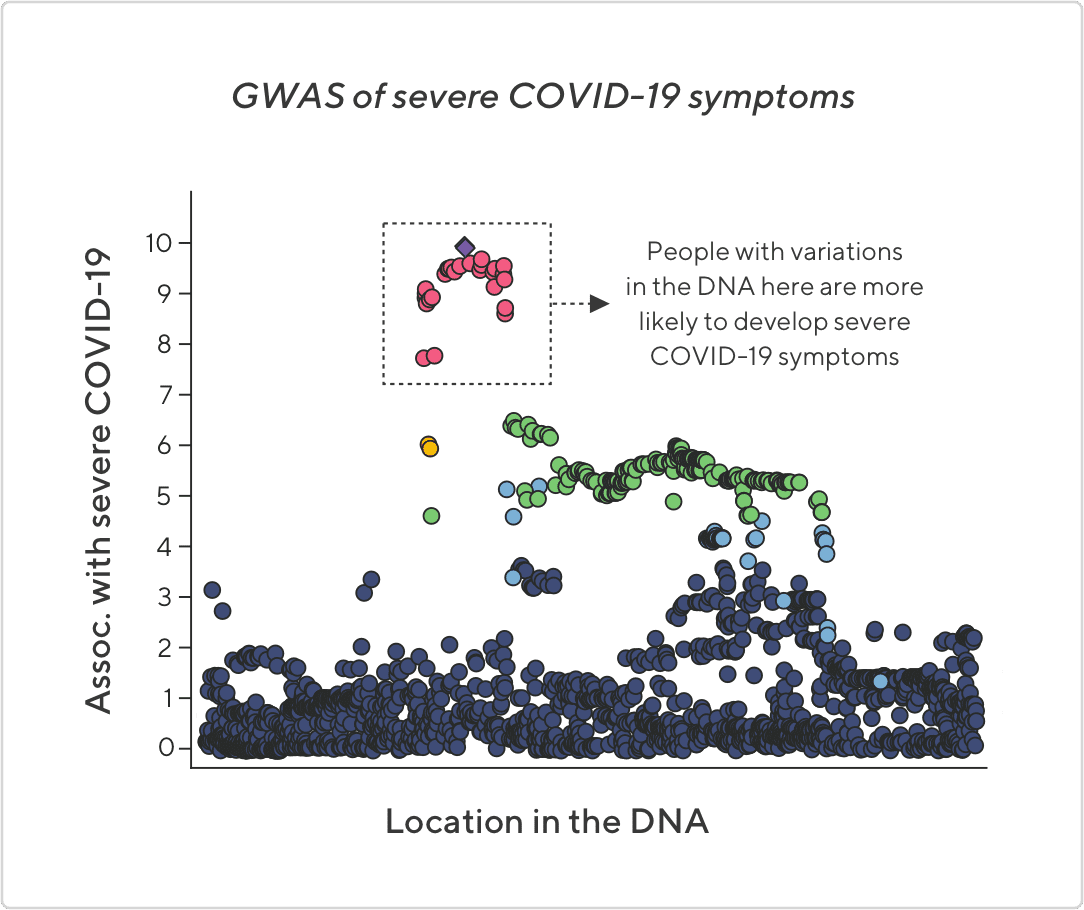Update on COVID-19 research at Helix

Helix researchers have been working on several projects that all center on understanding and ultimately combating COVID-19.
This research wouldn’t be possible without the caring actions of the people that make up the Helix community, many of whom have filled out COVID-19 surveys and contributed genetic data to help us better understand this terrible pandemic.
And, we’re making progress.
Over the past few months, data collected from our COVID-19 survey has helped researchers shed light on potential genetic factors that may make a person more vulnerable to developing severe COVID-19; and have additionally reported on some possible new symptoms of COVID-19.
Below are the most recent findings that members of the Helix community have contributed to (via consenting to participate in research and filling out our online survey).
Genetic factors associated with severe COVID-19
In an article recently published in the New England Journal of Medicine, a large team of researchers described evidence that some people may have inherited variations in their DNA sequence that leaves them more vulnerable to developing severe COVID-19 symptoms.
The work was done using genetic data in combination with electronic health record data from hospitals in both Spain and Italy. Researchers compared DNA from people who had developed life-threatening symptoms of COVID-19 to DNA collected from other people.
In comparing DNA from these groups, the team found that two patterns (existing in two different locations in the DNA) seemed to occur more frequently in people with severe symptoms than it did in people with mild symptoms. And, statistical analyses suggest that this isn’t random chance, meaning that it’s likely that these locations in the DNA have some connection with the severity of COVID-19 symptoms.

This is a modified figure taken from the New England Journal of Medicine article. GWAS stands for Genome-Wide Association Study—a common technique in genetics research. Each dot represents a variation that researchers see in DNA when comparing people’s DNA. Dots that are higher up on the y-axis are more frequently found in people with severe COVID-19 symptoms. The red dots are found so often in people with severe COVID-19 that it is not likely due to random chance—meaning there may be a connection between the DNA in this location and COVID-19 symptoms.
It’s too early to say whether these genetic factors are causing severe COVID-19, but some evidence suggests that changes in the DNA sequence within one of these locations may affect immune cells in the lungs, which is particularly interesting given that severe COVID-19 involves an inflammation of the lungs.
To confirm their findings, this team of researchers turned to an international group of scientists, including Helix, for help.
In response to the COVID-19 pandemic, some of the leading research labs around the world joined together to study how genetics may influence COVID-19. These researchers hope to make it possible for genetic testing to be used as a screening tool to help identify those who may be more vulnerable to COVID-19 and to ultimately help them get aid.
Helix is among the many labs to join this worldwide collaboration, known as the Host Genetics Initiative (HGI). This means that Helix researchers are able to work with larger pools of data and to potentially make groundbreaking discoveries that aren’t possible with data from any one individual laboratory.
Data from Helix’s research community helped them show a connection between DNA and severe COVID-19
The article published in the New England Journal of Medicine relied in part on data from HGI to confirm their findings, and that included data that Helix’s research community have contributed. With this data, the team of researchers were able to confirm that one location in our DNA—the one linked to immune cell activity in the lungs—is associated with more severe COVID-19 symptoms.
What’s important to point out, however, is that this and other research projects have made one thing clear: The relationship between a person’s DNA and their vulnerability to COVID-19 is not straightforward and likely involves many, many factors. This means that the findings in this paper are important, but they alone cannot explain why some people experience debilitating symptoms while others experience none at all. It is more likely a combination of environmental factors, age, and more than one genetic factor.
Nonetheless, this finding inspires further research and may be an important puzzle piece that ultimately helps us form a coherent picture of this disease.
And we owe a thank you to the many people who participated, and continue to participate, in Helix’s COVID-19 survey.
Categories